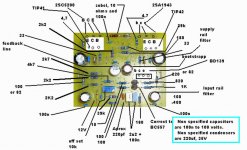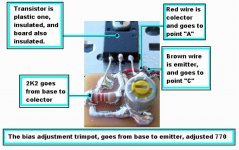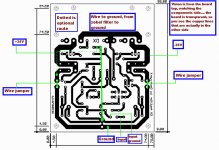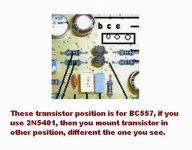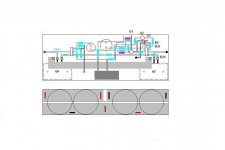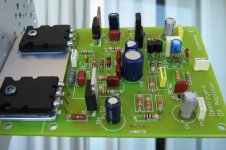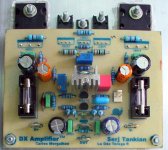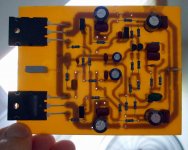download the Leach paper describing the operation and design of the lo tim.To be honest I haven't done much analog electronics in a while, I was originally hoping for an easy buy-parts-and-stick-them-together project but reading more of this thread I actually want to understand what's going on. I got my electronic devices textbook back out last night, I just need to find the time between finishing my masters and having a bit of a social life. This could take a bit longer than I expected, but I learn fast and I love to learn...
I'll see what I can do using my books and this thread. I will come back when I understand the circuit better.
Regards,
Ben
Similarly the Pass and Self sites give a lot of good design information with levels of understanding from beginners to intermediate.
download the Leach paper describing the operation and design of the lo tim.
Similarly the Pass and Self sites give a lot of good design information with levels of understanding from beginners to intermediate.
Good advice. I also found Paul Cambie's paper on the ETI480 very good. Like Prof Leach Paul has taken the time to decribe an amplifier from beginning to end.
Index of /~cambie/ETI480
regards
Hi guys, I have a good doubt here ..
I saw the original DX circuit is simple, even to modify for more power ..
And now I'm trying to mount amplifiers for professional use .. and then I wonder, with good cooling, a good source and some fuses (to protect against short), he would make a good amplifier, holding hours playing at most ...
Since now, thanks
-------------------------------
Because I am of Brazil, and I am using the google translator, and copied the wrong window rsrsrsrs, sorry
I saw the original DX circuit is simple, even to modify for more power ..
And now I'm trying to mount amplifiers for professional use .. and then I wonder, with good cooling, a good source and some fuses (to protect against short), he would make a good amplifier, holding hours playing at most ...
Since now, thanks
-------------------------------
Because I am of Brazil, and I am using the google translator, and copied the wrong window rsrsrsrs, sorry
Last edited:
Goto DHR Turbo thread Rafael, all you may need about informations are there
http://www.diyaudio.com/forums/solid-state/124931-dhr-dx-high-resolution-turbo.html
schematics, boards and all you may need are here, all Dx amplifiers are here:
http://users.tpg.com.au/users/gerskine/dxamp/
Use the google translator, read the entire thread in advance to build, several has built doing that, only reading the thread, and they succeed doing...so, there's you have all you may need...if not enougth, then you should be reading all forum for some monthes to acquire more skills.
Many friends have constructed, the only question they have sent me was about the substitution of diodes by transistor junctions, and i hope this was also clarified in the thread too.
I have openned these threads, dear Rafael, to save my time and to avoid to be repeating all stuff to each one of new friends that arrive here...so, before reading, then apply questions, read!
Good luck and be happy.
regards,
Carlos
......................................................................................................
Sorry folks to be so direct and cold, my people use to land in threads alike parachuters, some of them, sadly does not understand english, and they come to the last page and ask for special attenttion, without read the previous pages...in other words, some of them ask me to repeat everything already commented, once again, and in portuguese.... i have made that several times.... do you know what happened several times?... they have build anything, just spent my time...so, i know them very well..they are inside my blood and mind.
http://www.diyaudio.com/forums/solid-state/124931-dhr-dx-high-resolution-turbo.html
schematics, boards and all you may need are here, all Dx amplifiers are here:
http://users.tpg.com.au/users/gerskine/dxamp/
Use the google translator, read the entire thread in advance to build, several has built doing that, only reading the thread, and they succeed doing...so, there's you have all you may need...if not enougth, then you should be reading all forum for some monthes to acquire more skills.
Many friends have constructed, the only question they have sent me was about the substitution of diodes by transistor junctions, and i hope this was also clarified in the thread too.
I have openned these threads, dear Rafael, to save my time and to avoid to be repeating all stuff to each one of new friends that arrive here...so, before reading, then apply questions, read!
Good luck and be happy.
regards,
Carlos
......................................................................................................
Sorry folks to be so direct and cold, my people use to land in threads alike parachuters, some of them, sadly does not understand english, and they come to the last page and ask for special attenttion, without read the previous pages...in other words, some of them ask me to repeat everything already commented, once again, and in portuguese.... i have made that several times.... do you know what happened several times?... they have build anything, just spent my time...so, i know them very well..they are inside my blood and mind.
Last edited:
Hi.
I am an electronics engineering student, and I've been intrigued by your design. I have a project to build an amplifier using discrete solid-state components, minimum output 50w rms, and I'd really really like to build this amp.
My question is: since I'm a relative newbie to creating circuits (having soldered components to a PCB only around 5x in my entire life), is this project too complicated for me to build in time for submission? My project's deadline is around a month from now.
I am an electronics engineering student, and I've been intrigued by your design. I have a project to build an amplifier using discrete solid-state components, minimum output 50w rms, and I'd really really like to build this amp.
My question is: since I'm a relative newbie to creating circuits (having soldered components to a PCB only around 5x in my entire life), is this project too complicated for me to build in time for submission? My project's deadline is around a month from now.
Here you have some images that may help you to decide
and also to allow you to make a self evaluation if you can do it or not.
The site with schematics and more details:
Greg's Web Site
regards,
Carlos
and also to allow you to make a self evaluation if you can do it or not.
The site with schematics and more details:
Greg's Web Site
regards,
Carlos
Attachments
Good idea?.. wanna by adress?
Good...this one is nice..the other , the horse shoe, was not.
But cannot send more than a board, a single board, without parts, or customs will block..also have to write what is inside and say cost if 5 USD... so, " home made circuit board without components and value 5 USD."
If a transistor goes together..then they will say this is non legal importation, will ask me 50 bucks of taxation. They did that several years ago, was Klaas Veenstra boards, send as gift, having two Sankens transistors inside the package,
Then customs call me to go to their office...i dennied to go..then they wait one year and sent me by mail and without taxation....bureaucracy!
regards,
Carlos
Good...this one is nice..the other , the horse shoe, was not.
But cannot send more than a board, a single board, without parts, or customs will block..also have to write what is inside and say cost if 5 USD... so, " home made circuit board without components and value 5 USD."
If a transistor goes together..then they will say this is non legal importation, will ask me 50 bucks of taxation. They did that several years ago, was Klaas Veenstra boards, send as gift, having two Sankens transistors inside the package,
Then customs call me to go to their office...i dennied to go..then they wait one year and sent me by mail and without taxation....bureaucracy!
regards,
Carlos
Last edited:
dear sir
greetings has any circuit of dx amplifier been published using 4 transistors in output
saw it on u tube devils throat using big u aluminium heatsink.HAVE one dx amplifier working
trying to make one for my sony subwoofer 200 watts 2 ohm can dx be modified for 200
watts using more output transistors
thanking you
andrew lebon
greetings has any circuit of dx amplifier been published using 4 transistors in output
saw it on u tube devils throat using big u aluminium heatsink.HAVE one dx amplifier working
trying to make one for my sony subwoofer 200 watts 2 ohm can dx be modified for 200
watts using more output transistors
thanking you
andrew lebon
and also to allow you to make a self evaluation if you can do it or not.
The site with schematics and more details:
Greg's Web Site
regards,
Carlos
Thanks for the site.
Regarding soldering and installation, I guess I could do that. Measuring transistor characteristics (current, voltage etc.) is doable, since we're studying that right now. Chassis ground and input ground though, I have no idea. Biasing transistors and adjusting using trimpots, I've done that a few times.
In our country (Philippines) students tend to use kits, since the universities focus on teaching the theory, leaving little time for application. That being said, I know quite a lot of enthusiasts who improvise. I'm just not one of them.
So, is this too big of a project for me? If so, can you suggest any simpler solid state amplifier projects?
Of course it can be modified, but this means waste of time
as we already have the DHR Turbo, and circuit is not too much different, you can understand it as "a Dx amplifier modified to provide 200 watts or much more"
When amplifiers works with 2 ohms, distortion increases..better to use an amplifier that will provide you 200 watts in 8 ohms... will be more clean watts this way.... the Dx Standard, modified can produce 200 watts, with a sligthly bigger supply voltage and modifications..but will distort a lot...not a very good idea.
So, go to the DHR Turbo thread dear Andrewlebon and be happy melting some speaker coils.
Here you have some power specifications...output power when your supply voltage is the indicated...this is voltage under load conditions, amplifier operating full undistorted power:
DHR Turbo – revision 2... supply 70 plus 70 Vdc
Power RMS Rail current Total current. Impedance
610W 7.9A 15.8A 2 ohms
620W 6.5A 13.0A 3 ohms
485W 5.0A 10.0A 4 ohms
405W 4.0A 8.0A 5 ohms
340W 3.4A 6.8A 6 ohms
290W 2.9A 5.8A 7 ohms
270W 2.6A 5.2A 8 ohms
Input signal sinusoidal into 1Khz… continuous power into
The threshold of clipping.
Here is the link to the thread....there you have all you may want, also you have Greg site as support..in the thread there are charts showing you supply voltage and output power...read the thread in advance to build:
If you want the same sound you have in the Dx Standard, then substitute the current sink transistors by resistances, using same value you have in the Dx Standard....if you experience off set or other problems related voltage ballance, then adjust these resistances to zero off set and stable performance...but not really needed, DHR Turbo sounded very good, was not made to be very good, was made to produce huge power only...resulted good as an accident of destiny only.
http://www.diyaudio.com/forums/solid-state/124931-dhr-dx-high-resolution-turbo.html
regards,
Carlos
as we already have the DHR Turbo, and circuit is not too much different, you can understand it as "a Dx amplifier modified to provide 200 watts or much more"
When amplifiers works with 2 ohms, distortion increases..better to use an amplifier that will provide you 200 watts in 8 ohms... will be more clean watts this way.... the Dx Standard, modified can produce 200 watts, with a sligthly bigger supply voltage and modifications..but will distort a lot...not a very good idea.
So, go to the DHR Turbo thread dear Andrewlebon and be happy melting some speaker coils.
Here you have some power specifications...output power when your supply voltage is the indicated...this is voltage under load conditions, amplifier operating full undistorted power:
DHR Turbo – revision 2... supply 70 plus 70 Vdc
Power RMS Rail current Total current. Impedance
610W 7.9A 15.8A 2 ohms
620W 6.5A 13.0A 3 ohms
485W 5.0A 10.0A 4 ohms
405W 4.0A 8.0A 5 ohms
340W 3.4A 6.8A 6 ohms
290W 2.9A 5.8A 7 ohms
270W 2.6A 5.2A 8 ohms
Input signal sinusoidal into 1Khz… continuous power into
The threshold of clipping.
Here is the link to the thread....there you have all you may want, also you have Greg site as support..in the thread there are charts showing you supply voltage and output power...read the thread in advance to build:
If you want the same sound you have in the Dx Standard, then substitute the current sink transistors by resistances, using same value you have in the Dx Standard....if you experience off set or other problems related voltage ballance, then adjust these resistances to zero off set and stable performance...but not really needed, DHR Turbo sounded very good, was not made to be very good, was made to produce huge power only...resulted good as an accident of destiny only.
http://www.diyaudio.com/forums/solid-state/124931-dhr-dx-high-resolution-turbo.html
regards,
Carlos
Last edited:
Of course i suggest you to buy these books instead to download them
But i have found this in the internet, while surfing, and i cannot know how long this will be there.
Just for your curiosity, as i do not believe you prefere to download insted to buy.
You know, you can download, to study if the book is fine, as a preview..then you delete and go to buy... this way, you will be sure you will like the book.
regards,
Carlos
....................................................................................................
Douglas Self – Self On Audio (2ª edição): download | ifile.it
Douglas Self – Audio Power Amplifier Design Handbook (4ª edição): 9780750680721-0750680725.pdf.rar - download now for free. File sharing. Software file sharing. Free file hosting. File upload. FileFactory.com
Douglas Self, Bem Duncan, Chas Miller, etc: Audio Engineering: Know It All (Newnes Know It All): 185617526X.zip
Randy Slone – High Power Audio Amplifier Construction Manual: download | ifile.it
Randy Slone – Electronics Guide To Understanding Electricity and Electronics: download | ifile.it
Audio Engineering, know it all:
http://www.mediafire.com/?tzmymdaao1o
But i have found this in the internet, while surfing, and i cannot know how long this will be there.
Just for your curiosity, as i do not believe you prefere to download insted to buy.
You know, you can download, to study if the book is fine, as a preview..then you delete and go to buy... this way, you will be sure you will like the book.
regards,
Carlos
....................................................................................................
Douglas Self – Self On Audio (2ª edição): download | ifile.it
Douglas Self – Audio Power Amplifier Design Handbook (4ª edição): 9780750680721-0750680725.pdf.rar - download now for free. File sharing. Software file sharing. Free file hosting. File upload. FileFactory.com
Douglas Self, Bem Duncan, Chas Miller, etc: Audio Engineering: Know It All (Newnes Know It All): 185617526X.zip
Randy Slone – High Power Audio Amplifier Construction Manual: download | ifile.it
Randy Slone – Electronics Guide To Understanding Electricity and Electronics: download | ifile.it
Audio Engineering, know it all:
http://www.mediafire.com/?tzmymdaao1o
Last edited:
If you want 50 watts, exactly, then build the Dx amplifier
It is a 50 watter.
Several friends from Phillipines have assembled, and no one faced problems..go ahead!
I think you should take a look in the P3A from Rodd Elliot.... ESP pages in the internet.....P3A is even more simple and easier to build, also 50 watts i think.
Maybe P3A will be a good idea to you...type ESP and Rodd Elliot in the adress bar.
regards,
Carlos
It is a 50 watter.
Several friends from Phillipines have assembled, and no one faced problems..go ahead!
I think you should take a look in the P3A from Rodd Elliot.... ESP pages in the internet.....P3A is even more simple and easier to build, also 50 watts i think.
Maybe P3A will be a good idea to you...type ESP and Rodd Elliot in the adress bar.
regards,
Carlos
Attachments
Last edited:
- Status
- Not open for further replies.
- Home
- Amplifiers
- Solid State
- Destroyer x Amplifier...Dx amp...my amplifier
 Rafael
Rafael